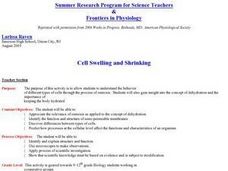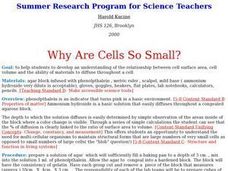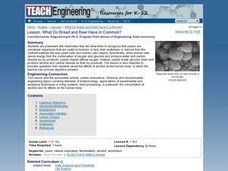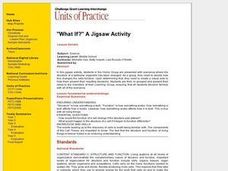Curated OER
DNA and Individual Differences
Students list differences between DNA-related terms and create a simple DNA circle map. They order terms including human body, organ, tissue, cell, nucleus, etc. from largest to smallest. They discuss differences and similarities among...
Curated OER
Cell City
Students understand how various cell parts function and how they are related to the genetic process by creating a model and symbol to depict the function of the cell parts. They research a cell part to determine function and then cut...
Curated OER
Use of Microscopes and Creation of Slides
Learners explore the use of microscopes and the creation of slides. They practice using, adjusting and viewing with a microscope. they view slides of familiar substances such as blood and fibers. In addition, they create slides using...
Curated OER
Respiration
Students study the gas exchanges that occur during cellular respiration. They observe what happens as a result of a number of variables on the rate of respiration. They use microrespirometers to measure the oxygen consumption of...
Curated OER
How Do Cells Reproduce?
Students discuss the importance of reproduction of cells. They identify and describe the stages of Mitosis. They discover what happens to chromosomes and DNA during reproduction.
Curated OER
"The Yeast of Our Worries"
Students study yeasts or cellular respiration in this inquiry activity. They examine different types of bread to show which rise or do not. They measure the amount of carbon dioxide released by the yeasts when using different sweeteners.
Curated OER
Cell Swelling and Shrinking
Students examine the concept of osmosis in relation to dehydration. They identify the function and structure of semi-permable membranes. They predict how certain processes can affect the characteristics of an organism.
Curated OER
Why Are Cells So Small?
Students examine the relationship between cell surface area and the ability of materials to diffuse through a cell. They participate in an experiment in which they determine which materials diffuse easier than others. They complete...
Curated OER
Cytoskeleton of a Cell
Learners examine the cytoskeleton of a cell. They work together to build a structure with a certain number of materials. They share their "cell" with their classmates.
Curated OER
How Can We Study the Differences in Animal and Plant Cells Using the Compound Microscope?
Students examine their cheek cells with a compound microscope. They identify different parts of the cell. They compare and contrast animal and plant cells with the microscope as well.
Curated OER
Cells are 3-D!
Students design three dimensional models of plant and animal cells. They identify the cells parts, and compare animal and plant cells.
Curated OER
Science: Comparing Beer and Bread
Young scholars compare and contrast cellular respiration in yeast and plant and animal cells. After discovering the role of yeast in making beer and bread, they describe the short and long term effects of alcohol on the nervous and...
Curated OER
Spotlight on Photovoltaics and Fuel Cells
Learners conduct Internet research to examine the pros and cons of photovoltaics and fuel cells. They watch a web simulation on fuel cells, complete a handout, and create molecular models using pipe cleaners and gum drops.
Curated OER
Making Blood!
students research blood's components, and use their math skills to recreate a model of whole blood using commonly found food items.
Curated OER
ACTIVE TRANSPORT ACROSS THE PLASMA MEMBRANE
Students comprehend that energy is required to move substances across the cell membrane against the concentration gradient.
Curated OER
Cancer: A Crisis of the Cells
Pupils analyze cancer data represented in graphs and charts. They describe the changes in cell structure and function as the result of cancer. They also examine phenomenas that are believed to cause cancer.
Curated OER
Who Are We? An Introduction to the Life Within Our Bodies
Students examine cell structure, cell division, and the basic structure of DNA. They read and discuss a case study of DNA research, answer discussion questions, role-play the process of mitosis, and complete a DNA Fact or Fiction worksheet.
Curated OER
Parts of the Cell
High schoolers examine plant and animal cells to observe the organelles present in the cell, to match the function of each to the organelle on a cell model and to build a model of the plant or animal cell.
Curated OER
Looking Inside Cells
Seventh graders examine the functions and roles of membranes in cells. They discover the differences between plant and animal cells.
Curated OER
What Becomes of Cell?
Sixth graders analyze and compare a cell's tissues, organs and organ systems. They watch a video reviewing the body systems and design poster boards showing their functions.
Curated OER
Looking Inside Cells
Seventh graders analyze and identify the role of the cell membrane and nucleus. They create flash cards to help them review cell structures. They also compare plant and animal cells.
Curated OER
What is an Organism?
Sixth graders take a pre-test and summarize teacher's discussion of cells, tissues, organs in their notebooks. They read selections on organisms in their textbook and perform a dissection of a chicken drumstick with the thigh attached....
Curated OER
Cell Structures and Functions
Fifth graders search into animal and cell characteristics and their functions in this seven lesson unit. Replicas of the cell are constructed out of Jell-O as students probe the internet for details of the concepts.
Curated OER
"What If?" A Jigsaw Activity
Students, in groups, consider a scenario in which some structure of a cell has been changed. They explore how structural change affects the function of a cell and create a visual aid to illustrate their observations.

























